- Books Name
- CBSE Class 6 Science Book
- Publication
- Param Publication
- Course
- CBSE Class 6
- Subject
- Science
Activity–3
AIM : To prove that some solids are soluble in water.
Material required : (i) A rack of test tubes (ii)water (iii)common salt (iv)sugar (v)washing soda (vi)chalk powder and sand.
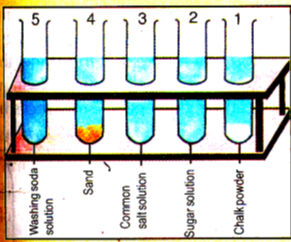
Method : Add a pinch of chalk powder in the first test tube, a pinch of sugar in second test tube, a pinch of common salt in the third test tube, a pinch of sand in the fourth test tube and a pinch of washing soda in the fifth test tube. Pour water into each test tube such that half of each test tube is filled with water. Shake each test tube vigorously and replace in the rack. You will notice that sugar, common salt and washing soda disappear in water, and hence are soluble substances. Sand and chalk powder do not dissolve in water, and hence are insoluble substances.
Some liquids like vinegar, lemon juice etc. completely mix with water. These liquids are said to be miscible in water. Some others like oil do not mix with water and form a separate layer when kept aside for some time. These liquid are immiscible in water. Some gases are soluble in water whereas others are not. Water, usually, has small quantities of some gases dissolved in it. For example, oxygen gas dissolved in water is very important for the survival of animals and plants that live in water.
(iv) Objects may float or sink in water :
Insoluble solids separate out from water. Some of these materials that do not mix with water, float to the surface of water. Others may sink to the bottom of the tumbler.
Some substances like oil, wood etc. float on water while substances like stone, metal piece etc sink in it.
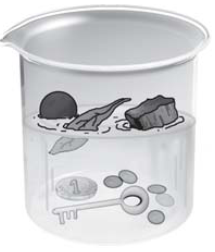
Some objects float in water while others sink in it
Activity–4
AIM : To find out substance which sink/float in water.
Material required : (i) a small stone (ii) a small piece of wood (iii)a coin (iv)a leaf (v)a brass screw
(vi) a small piece of ice (vii)a glass bowl filled with water.
Method : Take a glass bowl filled with water. In the water, drop the above mentioned substances one by one and observe what happens. We will notice that the stone, the key, the coin and the brass screw sink in water. Thus, they can be grouped as substances heavier than water.
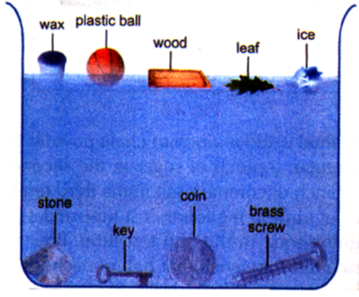
Fig. Material which sink or float in water
We will notice that the wax, the plastic ball, the wood, the leaf and ice float on the surface of water. Thus, they can be grouped as substances lighter than water. We can repeat the activity by dropping the above substances in kerosene oil or any other liquid and find out which float or sink in it.
(v) Transparency :
Those substances or materials, through which things can be seen, are called transparent. Light passes completely through these materials. Glass, water, air and some plastics are examples of transparent materials.
On the other hand, there are some materials through which we are not able to see i.e. light does not pass through them. These materials are called opaque. Wood, cardboard and metals, are example of opaque materials.
The materials through which light passes partially and objects can be seen but not clearly, are known as translucent. We can therefore group materials as opaque, transparent and translucent.
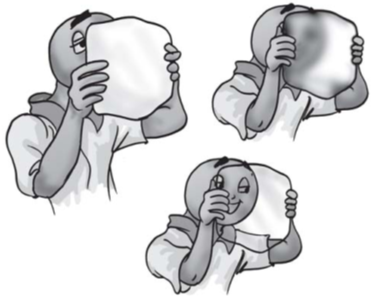
Looking through opaque, transparent or translucent material
Our palm is also translucent. When we put palm on torch then partially light passes through the hand. It prooves that our palm is also translucent.
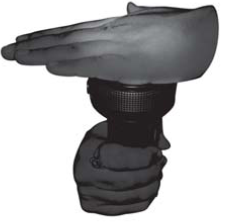
Does torch light pass through your palm?
- Books Name
- Class 6 Science Book
- Publication
- PathSet Publications
- Course
- CBSE Class 6
- Subject
- Science
Properties of Materials
1. Appearance
Materials can be classified on the basis of how they look or appear to be. Some materials have lustre, which is a very gentle sheen or soft glow to them while others are plain and dull looking. Materials that have such lustre can usually be classified as Metals. Examples include gold, copper, aluminum, iron etc. Usually, a metal loses its lustre after some time due to the action of moisture and air on it. Therefore, only freshly-cut metals appear to have lustre on them.
Lustre:
Lustre is the shine of a material. All metals in pure state are shiny and said to possess lustre. This property of metals is widely used for making jewellery and other decorative articles. Materials like gold, silver, and bronze have lustre (Fig. 5.2).

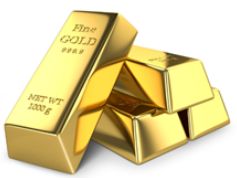
2. Hardness and Roughness
Materials can also be classified on the basis of hardness.
Materials that can be easily compressed or scratched are called Soft.
Materials that cannot be scratched and are difficult to compress are termed as Hard.
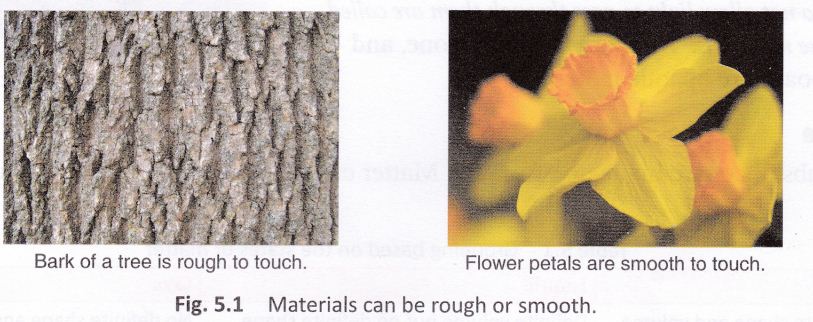
Roughness: Materials can be rough or smooth. Rough materials have bumps or ridges on their surface, which can be felt by touching them. Smooth materials lack these bumps. Examples of rough materials are rocks, sandpaper, and bark of a tree. A glass sheet, flower petals, and surface of an apple are some examples of smooth surfaces (Fig. 5.1).
3. Soluble or Insoluble
Solubility:
Different materials have different solubility in water. Based on their solubility, materials can be soluble, insoluble, miscible, or immiscible.
Solid materials that dissolve in water are said to be soluble in water. For example, common salt and sugar. Solid materials that do not dissolve in water are said to be insoluble in water. For example, sand, wood, stone, chalk powder, and wax. Liquids that dissolve in water are said to be miscible in water. For example, alcohol, vinegar, lemon juice, honey, and glycerin. Liquids that do not dissolve in water are said to be immiscible in water. For example, kerosene, coconut oil, and diesel.
Some gases dissolve in water (e.g., carbon dioxide and oxygen). Oxygen dissolved in water is essential for the survival of aquatic organisms. Soft drinks have carbon dioxide dissolved in them. Gases like nitrogen, hydrogen, and helium are insoluble in water.
Materials that can be dissolved in water upon stirring are said to be soluble materials. For Example, Sugar and Salt can be dissolved in water.
Materials that cannot be dissolved in water no matter how much we stir them are said to be insoluble materials. For Example, Stones and Clothes cannot be dissolved in water.
Not just solid materials, even liquids have the property of being soluble or insoluble. For Example, Lemon juice can easily dissolve in water while oil does not dissolve and deposits as a thin layer on the uppermost layer of water.
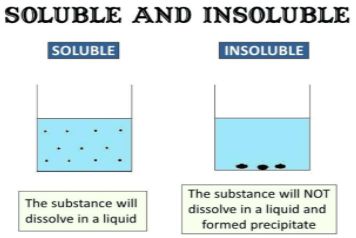
4. Objects may float or sink in water
Flotation:
Certain materials float on water whereas others sink. This property of a material to float on water is called flotation. Generally, materials like wood, leaf, and feather float on water whereas rock and metal sink.
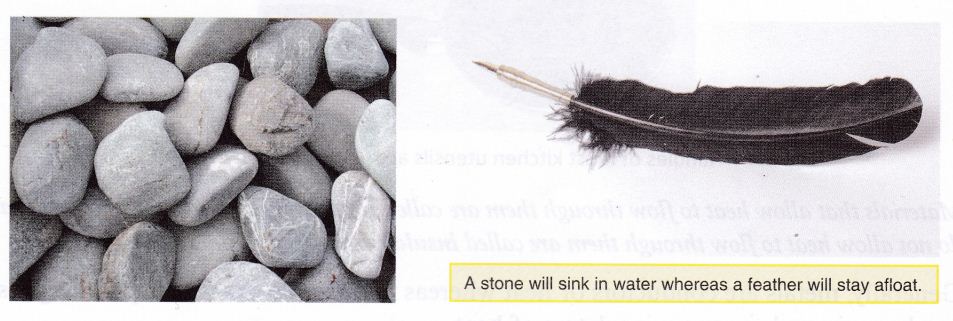
There are some insoluble objects or materials which sink to the bottom of the surface when dissolved in water while some other float on the surface of the water. For Example, leaves and corks float in water while rocks and coins sink in water.
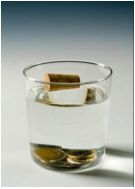
5. Transparency
Objects or materials which can be seen through are said to be transparent objects. For Example, Glass, clear water and some plastics can be seen through and are hence transparent materials.
Objects and materials through which things can be seen but only partially are called Translucent objects. Butter paper and frosted glass are some examples of translucent objects.
Objects which cannot be seen through are known as opaque objects. For Example, Metals, wood and cardboard are some examples of opaque materials as you cannot see through them.
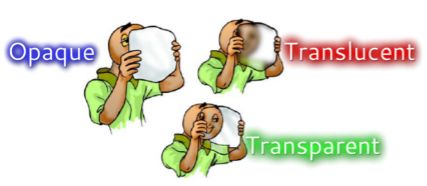
Thus, we can group objects on the basis of their appearance, whether they are hard or soft, whether or not they can be compressed, if they dissolve in water or not and if they don’t do they float or sink and lastly if they can be seen through clearly, partially or at all. In this way, materials can be grouped on the basis of their similarities and differences.
6. Attraction towards a magnet:
Materials that are attracted to a magnet are called magnetic materials. This property is called magnetism. Objects made of iron are attracted to a magnet. In addition to iron, nickel and cobalt are also attracted to a magnet.
7. Conduction of heat:
If you observe the utensils in your kitchen, you will notice that though most of them are made of metals, their handles are made of wood or hard plastic.
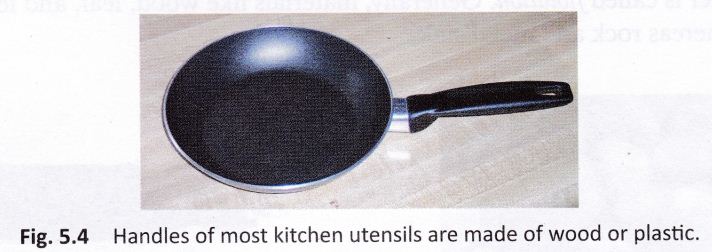
Why aren’t the handles made of metal as well? This is because metals get heated whereas materials like plastic and wood do not (Fig. 5.4). It would be difficult to hold the handles made of metal while cooking.
Materials that allow heat to flow through them are called conductors of heat whereas those that do notallow heat to flow through them are called insulators of heat.
Generally, metals are conductors of heat whereas non-metals like wood, plastic, glass, bamboo, air, and paper are insulators of heat.
8. Conduction of electricity:
We get electricity in our homes through cables and wires. An electric cable consists of a number of metal wires with or without a plastic covering (Fig. 5.5). The metal wires conduct or transmit electricity whereas the plastic covering do not. Materials that conduct electricity are called conductors. Materials that do not conduct electricity are called insulators. For example, metals are conductors of electricity; wood, air, and plastic are insulators.
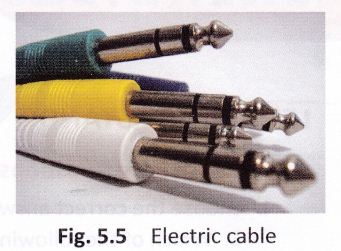
Important Terms:
- All objects around us are made up of one or more materials.
- Materials have different properties that make them useful for making different objects.
- An object can be made from different materials.
- Different objects can be made from the same material.
- Materials can be rough or smooth, transparent or opaque, soluble in water or insoluble, can float on water or sink; can be a conductor or insulators of heat or electricity.
- Transparent Materials that allow light to pass through them are called transparent materials.
- Translucent Materials that allow some light to pass through them are called translucent materials.
- Opaque Materials that do not allow light to pass through them are called opaque materials.
- Miscible Liquids that are soluble in water are said to be miscible in water.
- Immiscible Liquids that are insoluble in water are said to be immiscible in water.
- Magnetic materials Materials that are attracted by a magnet are called magnetic materials.
- Conductors Materials that conduct heat or electricity are called conductors.
- Insulators Materials that do not conduct heat or electricity are called insulators

 Param Publication
Param Publication
 PathSet Publications
PathSet Publications
